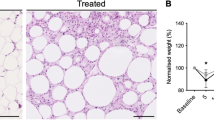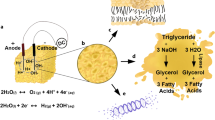Abstract
Collection of abdominal subcutaneous adipose tissue (SAT) for research testing is traditionally performed using punch biopsy or needle aspiration techniques, yielding small amounts of very superficial SAT (100–500 mg). Although liposuction techniques can be used to obtain large amounts of SAT, these approaches can compromise the integrity of the adipose tissue. Therefore, we investigated a novel method using a 6-mm Bergström side-cutting biopsy needle to acquire suitable amounts of intact abdominal SAT for multiple complex studies such as flow cytometry, RNA extraction, ex vivo expression of molecular and post-translational protein mediators, and histology. Fifty biopsies were obtained from 29 participants using a Bergström biopsy needle, applying transient manual suction and shearing large pieces of fat within the inner-cutting trochar. Eighteen of the biopsies were performed under ultrasound guidance, whereby we successfully sampled deep SAT (dSAT) from below Scarpa’s fascia. The average weight of SAT sampled was 1.5±0.4 g. There was no clinically important bleeding or ecchymosis on the abdominal wall and no infection occurred with this procedure. The 6-mm Bergström biopsy needle yielded substantially more SAT than what has been obtained from superficial procedures and, for the first time, allowed sampling of dSAT by a percutaneous approach.
This is a preview of subscription content, access via your institution
Access options
Subscribe to this journal
Receive 12 print issues and online access
$259.00 per year
only $21.58 per issue
Buy this article
- Purchase on Springer Link
- Instant access to full article PDF
Prices may be subject to local taxes which are calculated during checkout


Similar content being viewed by others
References
Fox CS, Massaro JM, Hoffmann U, Pou KM, Maurovich-Horvat P, Liu C-Y et al. Abdominal visceral and subcutaneous adipose tissue compartments: association with metabolic risk factors in the Framingham Heart Study. Circulation 2007; 116: 39–48.
Goodpaster B, Thaete F, Simoneau J, Kelley D . Subcutaneous abdominal fat and thigh muscle composition predict insulin sensitivity independently of visceral fat. Diabetes 1997; 46: 1579–1585.
Patel P, Abate N . Body fat distribution and insulin resistance. Nutrients 2013; 5: 2019–2027.
Kelley DE, Thaete FL, Troost F, Huwe T, Goodpaster BH . Subdivisions of subcutaneous abdominal adipose tissue and insulin resistance. Am J Physiol Endocrinol Metab 2011; 278: E941–E948.
Walker GE, Verti B, Marzullo P, Savia G, Mencarelli M, Zurleni F et al. Deep subcutaneous adipose tissue: a distinct abdominal adipose depot. Obesity (Silver Spring) 2007; 15: 1933–1943.
Item F, Konrad D . Visceral fat and metabolic inflammation: the portal theory revisited. Obes Rev 2012; 13: 30–39.
Tchernof A, Després JP . Pathophysiology of human visceral obesity: an update. Physiol Rev 2013; 93: 359–404.
Alvehus M, Burén J, Sjöström M, Goedecke J, Olsson T . The human visceral fat depot has a unique inflammatory profile. Obesity 2010; 18: 879–883.
Tordjman J, Divoux A, Prifti E, Poitou C, Pelloux V, Hugol D et al. Structural and inflammatory heterogeneity in subcutaneous adipose tissue: relation with liver histopathology in morbid obesity. J Hepatol 2012; 56: 1152–1158.
Marinou K, Hodson L, Vasan SK, Fielding BA, Banerjee R, Brismar K et al. Structural and functional properties of deep abdominal subcutaneous adipose tissue explain its association with insulin resistance and cardiovascular risk in men. Diabetes Care 2014; 37: 821–829.
Smith SR, Lovejoy JC, Greenway F, Ryan D, deJonge L, la Bretonne de J et al. Contributions of total body fat, abdominal subcutaneous adipose tissue compartments, and visceral adipose tissue to the metabolic complications of obesity. Metab Clin Exp 2001; 50: 425–435.
Kolak M, Westerbacka J, Velagapudi VR, Wågsäter D, Yetukuri L, Makkonen J et al. Adipose tissue inflammation and increased ceramide content characterize subjects with high liver fat content independent of obesity. Diabetes 2007; 56: 1960–1968.
Bigornia SJ, Farb MG, Mott MM, Hess DT, Carmine B, Fiscale A et al. Relation of depot-specific adipose inflammation to insulin resistance in human obesity. Nutr Diabetes 2012; 2: e30.
Lê K-A, Mahurkar S, Alderete TL, Hasson RE, Adam TC, Kim JS et al. Subcutaneous adipose tissue macrophage infiltration is associated with hepatic and visceral fat deposition, hyperinsulinemia, and stimulation of NF-κB stress pathway. Diabetes 2011; 60: 2802–2809.
Campbell KL, Makar KW, Kratz M, Foster-Schubert KE, McTiernan A, Ulrich CM . A pilot study of sampling subcutaneous adipose tissue to examine biomarkers of cancer risk. Cancer Prev Res (Phila) 2009; 2: 37–42.
Daum SM, Knittle J, Roseman K, Rom WN, Holstein EC . A simple technique for fat biopsy of PBB-exposed individuals. Environ Health Perspect 1978; 23: 183–185.
Pasarica M, Gowronska-Kozak B, Burk D, Remedios I, Hymel D, Gimble J et al. Adipose tissue collagen VI in obesity. J Clin Endocrinol Metab 2009; 94: 5155–5162.
Tam CS, Covington JD, Bajpeyi S, Tchoukalova Y, Burk D, Johannsen DL et al. Weight gain reveals dramatic increases in skeletal muscle extracellular matrix remodeling. J Clin Endocrinol Metab 2014; 99: 1749–1757.
Bastard JP, Cuevas J, Cohen S, Jardel C, Hainque B . Percutaneous adipose tissue biopsy by mini-liposuction for metabolic studies. JPEN J Parenter Enteral Nutr 1994; 18: 466–468.
van Beek L, Lips MA, Visser A, Pijl H, Ioan-Facsinay A, Toes R et al. Increased systemic and adipose tissue inflammation differentiates obese women with T2DM from obese women with normal glucose tolerance. Metab Clin Exp 2014; 63: 492–501.
Hagman DK, Kuzma JN, Larson I, Foster-Schubert KE, Kuan L-Y, Cignarella A et al. Characterizing and quantifying leukocyte populations in human adipose tissue: impact of enzymatic tissue processing. J Immunol Methods 2012; 386: 50–59.
Acknowledgements
This work was supported by the SC CTSI (NIH/NCRR/NCATS) Grant # UL1TR000130 (TLA) and the Robert C and Veronica Atkins Foundation (MIG). TLA (principal investigator) supervised all aspects of the study, assisted with biopsies and was responsible for data analysis and manuscript preparation. MIG (coinvestigator) acted as study sponsor and mentor. FRS (coinvestigator) was the study physician and performed biopsies. EGG helped develop ultrasound-imaging procedures, while SDM, XS and JT developed the adipose tissue-processing protocols. All coauthors assisted with manuscript preparation.
Author information
Authors and Affiliations
Corresponding author
Ethics declarations
Competing interests
The authors declare no conflict of interest.
Rights and permissions
About this article
Cite this article
Alderete, T., Sattler, F., Sheng, X. et al. A novel biopsy method to increase yield of subcutaneous abdominal adipose tissue. Int J Obes 39, 183–186 (2015). https://doi.org/10.1038/ijo.2014.90
Received:
Revised:
Accepted:
Published:
Issue Date:
DOI: https://doi.org/10.1038/ijo.2014.90
This article is cited by
-
Near-roadway air pollution, immune cells and adipokines among obese young adults
Environmental Health (2022)



